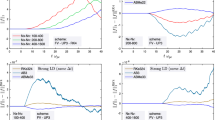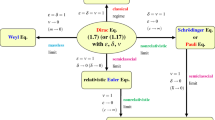Abstract
We develop a splitting Chebyshev collocation (SCC) method for the time-dependent Schrödinger–Poisson (SP) system arising from theoretical analysis of quantum plasmas. By means of splitting technique in time, the time-dependant SP system is first reduced to uncoupled Schrödinger and Poisson equations at every time step. The space variables in Schrödinger and Poisson equations are next represented by high-order Chebyshev polynomials, and the resulting system are discretized by the spectral collocation method. Finally, matrix diagonalization technique is applied to solve the fully discretized system in one dimension, two dimensions and three dimensions, respectively. The newly proposed method not only achieves spectral accuracy in space but also reduces the computer-memory requirements and the computational time in comparison with conventional solver. Numerical results confirm the spectral accuracy and efficiency of this method, and indicate that the SCC method could be an efficient alternative method for simulating the dynamics of quantum plasmas.






Similar content being viewed by others
References
Anderson D et al (2002) Statistical effects in the multistream model for quantum plasmas. Phys Rev E 65:046417
Becker KH, Schoenbach KH, Eden JG (2006) Microplasmas and applications. J Phys D 39:R55
Bao W, Mauser NJ, Stimming HP (2003) Effective one particle quantum dynamics of electrons: a numerical study of the Schrödinger–Poisson-\(\Xi \alpha \) model. Comm Math Sci 1:809–831
Abdallah N Ben (2000) On a multidimensional Schrödinger–Poisson scattering model for semiconductors. J Math Phys 41(7):4241–4261
Brezzi F, Markowich PA (1991) The three-dimensional Wigner–Poisson problem: existence, uniqueness and approximation. Math Meth Appl Sci 14:35–61
Canuto C, Hussaini MY, Quarteroni A, Zang TA (1987) Spectral methods in fluid dynamics. Springer, Berlin
Cheng C, Liu Q, Lee J, Massoud HZ (2004) Spectral element method for the Schrödinger–Poisson system. J Comput Electron 3:417–421
Castella F (1997) \(L^2\) solutions to the Schrödinger–Poisson system: existence, uniqueness, time behavior, and smoothing effects. Math Mod Meth Appl Sci 7:1051–1083
Dong X (2011) A short note on simplified pseudospectral methods for computing ground state and dynamics of spherically symmetric Schrödinger–Poisson-Slater system. J Comput Phys 230:7917–7922
Ehrhardt M, Zisowsky A (2006) Fast calculation of energy and mass preserving solutions of Schrödinger–Poisson systems on unbounded domains. J Comput Appl Math 187:1–28
Harrison R, Moroz IM, Tod KP (2003) A numerical study of Schrödinger–Newton equations. Nonlinearity 16:101–122
Haas F, Manfredi G, Feix M (2000) Multistream model for quantum plasmas. Phys Rev E 62:2763
Haas F (2003) Quantum ion-acoustic waves. Phys Plasmas 10:3858–3866
Lange H, Toomire B, Zweifel PF (1995) An overview of Schrödinger–Poisson Problems. Rep Math Phys 36:331–345
Lubich C (2008) On splitting methods for Schrödinger–Poisson and cubic nonlinear Schrödinger equations. Math Comput 77:2141–2153
Mauser NJ, Zhang Y (2014) Exact artificial boundary condition for the Poisson equation in the simulation of the 2D Schrödinger–Poisson system. Commun Comput Phys 16:764–780
Manfredi G, Haas F (2001) Self-consistent fluid model for a quantum electron gas. Phys Rev B 64:075316
Manfredi G (2005) How to model quantum plasmas. Fields Inst Commun 46(263):2005
Markowich PA, Ringhofer CA, Schmeiser C (1990) Semiconductor equations. Springer, Berlin
Moroz I, Penrose R, Tod P (1998) Spherically-symmetric solutions of the Schrödinger–Newton equations. Class Quantum Grav 15:2733–2742
Opher M, Silva LO, Dauger DE, Decyk VK, Dawson JM (2001) Nuclear reaction rates and energy in stellar plasmas: the effect of highly damped modes. Phys Plasmas 8:2454–2460
Peyret R (2002) Spectral methods for incompressible viscous flow. Springer, New York
Shaikh D, Shukla PK (2008) 3D electron fluid turbulence at nanoscales in dense plasmas. New J Phys 10(083007):1–7
Shen J (2006) Efficient spectral-Galerkin method II. direct solvers of second- and fourth-order equations using Chebyshev polynomials. SIAM J Sci Comput 16:74–87
Shukla PK, Eliasson B (2010) Nonlinear aspects of quantum plasma physics. Phys Usp 53:51–76
Shukla PK, Stenflo L (2006) Stimulated scattering instabilities of electromagnetic waves in an ultracold quantum plasma. Phys Plasmas 13:044505
Shukla PK, Eliasson B (2007) Nonlinear interactions between electromagnetic waves and electron plasma oscillations in quantum plasmas. Phys Rev Lett 99:096401
Shukla PK, Eliasson B (2006) Formation and dynamics of dark solitons and vortices in quantum electron plasmas. Phys Rev Lett 96:245001
Sulem C, Sulem PL (1999) The nonlinear Schrödinger equation: self-focusing and wave collapse. Springer, Berlin
Tan IH, Snider GL, Chang LD, Hu EL (1990) A self-consistent solution of Schrödinger–Poisson equations using a nonuniform mesh. J Appl Phys 68:4071–4076
Tod P, Moroz IM (1999) An analytical approach to the Schrödinger–Newton equations. Nonlinearity 12:201–216
Zhang Y (2013) Optimal error estimates of compact finite difference discretizations for the Schrödinger–Poisson system. Commun Comput Phys 13:1357–1388
Zhang Y, Dong XC (2011) On the computation of ground state and dynamics of Schrödinger–Poisson–Slater system. J Comput Phys 230:2660–2676
Zheng C (2007) A perfectly matched layer approach to the nonlinear Schrödinger wave equations. J Comput Phys 227:537–556
Wang Y, Lu X (2014) Modulational instability of electrostatic acoustic waves in an electron-hole semiconductor quantum plasma. Phys Plasma 21:022107
Wang H (2010) An efficient Chebyshev–Tau spectral method for Ginzburg–Landau–Schrödinger equations. Comput Phys Commun 181:325–340
Acknowledgements
The research of Z. Liang is supported in part by the Natural Science Foundation of China under Grant nos. 11371097, 11571249. The research of H. Wang is supported in part by the Natural Science Foundation of China under Grant no. 91430103.
Author information
Authors and Affiliations
Corresponding author
Additional information
Communicated by Pierangelo Marcati.
Rights and permissions
About this article
Cite this article
Wang, H., Liang, Z. & Liu, R. A splitting Chebyshev collocation method for Schrödinger–Poisson system. Comp. Appl. Math. 37, 5034–5057 (2018). https://doi.org/10.1007/s40314-018-0616-4
Received:
Accepted:
Published:
Issue Date:
DOI: https://doi.org/10.1007/s40314-018-0616-4




